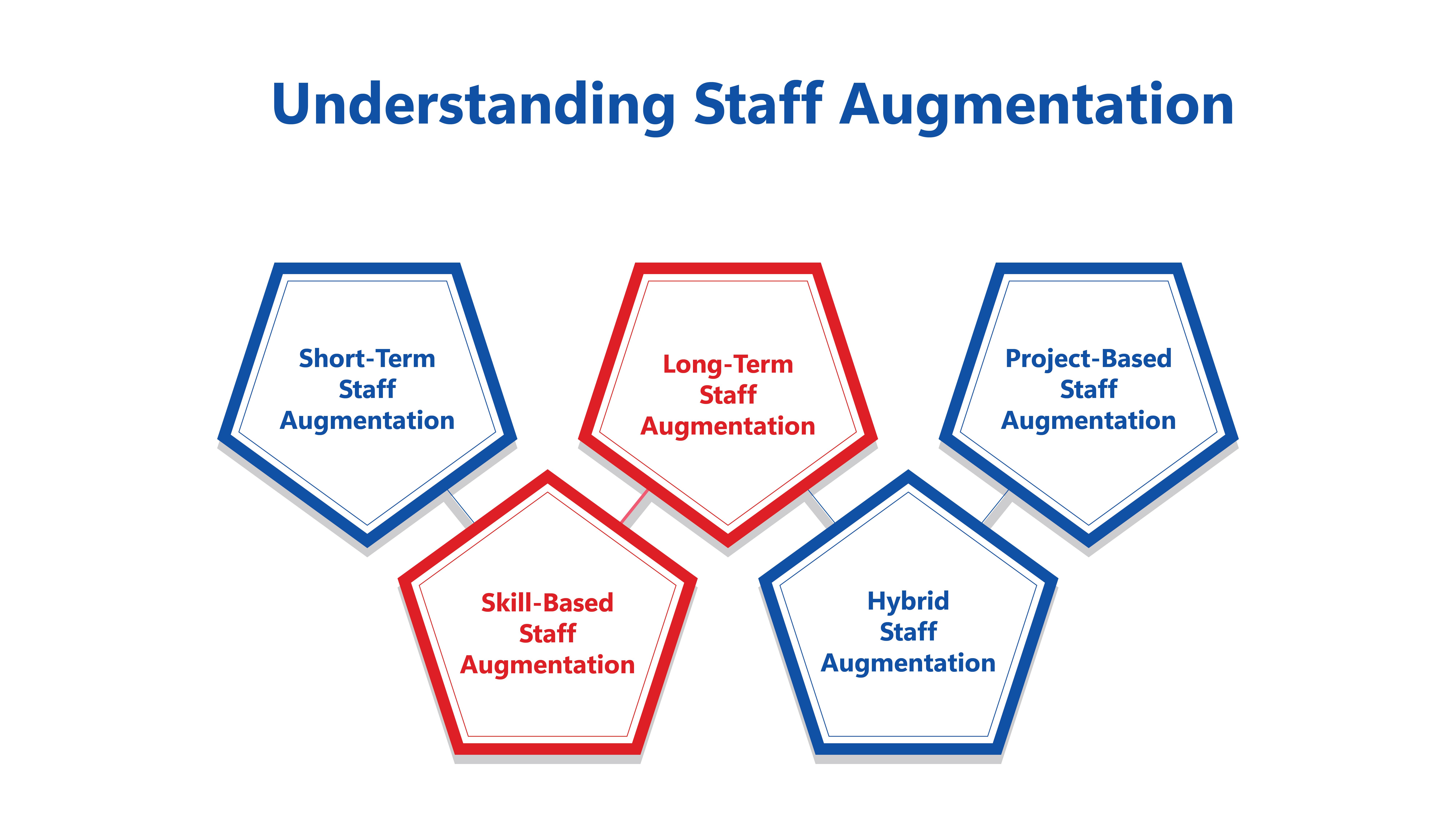Staffing has become a critical component of an organization’s success, the right staffing model can enable companies to be agile, respond to market changes, and innovate faster. Among the various staffing strategies available, staff augmentation stands out as a flexible and efficient solution.
This approach allows businesses to hire dedicated employees for specific projects or workloads, thereby enhancing their capacity without the long-term commitment of traditional employment. This blog will explore different types of staff augmentation and guide organizations in finding the perfect fit for their staffing needs.
Understanding Staff Augmentation

Staff augmentation is an outsourcing strategy where businesses bring in additional talent to temporarily join their in-house teams. This approach is highly beneficial for companies facing fluctuating project demands, as it provides the flexibility to scale their workforce up or down as needed. Staff augmentation allows organizations to access specialized skills and reduce the overhead expenses associated with permanent employees. Depending on the specific needs of an organization, staff augmentation can be classified into several types, each with its unique advantages and use cases.
Short-Term Staff Augmentation
Short-term staff augmentation involves hiring workers from external sources for a brief period to fill temporary gaps in the workforce. This arrangement can last from a few weeks to several months, depending on the project’s needs.
Use Cases:
-
Project Spikes: Companies experiencing a sudden increase in workload due to new projects or seasonal demands can benefit from short-term staffing. This approach ensures that organizations meet their targets without overburdening their existing employees.
-
Specialized Expertise: Short-term augmentation is ideal for projects requiring specific skills or knowledge that the in-house team lacks. For example, a software development project might need a cybersecurity expert for a security audit for just a few weeks.
-
Resource Replacement: Temporary staff can also cover for employees on leave, such as maternity or medical leave, to prevent disruptions in operations.
Benefits:
-
Flexibility: Organizations can quickly adjust their workforce size according to project requirements.
-
Cost-Effectiveness: Reduces long-term liabilities and expenses associated with permanent employees.
-
Speed: Enables rapid recruitment of skilled workers to meet urgent project needs.
Also Read: Top Benefits of Recruitment Process Outsourcing for Growing Businesses
Long-Term Staff Augmentation
Long-term staff augmentation involves employing external personnel for extended periods, typically lasting several months to years. This model is suited for ongoing projects or strategic initiatives requiring consistent support.
Use Cases:
-
Ongoing Projects: Complex projects that span multiple years, such as large-scale software development or IT system overhauls, benefit from the continuity provided by long-term staff augmentation.
-
Strategic Initiatives: For initiatives like digital transformation or market expansion, long-term augmentation ensures that the organization has the necessary workforce throughout the project’s lifecycle.
-
Skills Retention: Long-term relationships help retain critical skills and knowledge within the organization, leading to more consistent and high-quality project outcomes.
Benefits:
-
Consistency: Supports operations that require long-term planning and execution.
-
Knowledge Retention: Keeps valuable expertise within the organization for extended periods.
-
Integration: Long-term augmented staff can seamlessly integrate into existing teams, enhancing collaboration and efficiency.
Project-Based Staff Augmentation
Project-based staffing involves hiring external talent specifically for a defined project. Once the project is completed, the working relationship with the augmented staff typically ends.
Use Cases:
-
Defined Project Scope: Suitable for projects with clear objectives, timelines, and deliverables, such as software development, IT system implementation, or data migration.
-
Resource Optimization: Enables organizations to make optimal use of their resources by acquiring outsourced talent precisely when needed.
-
Cost Management: Aligns staffing costs with project budgets and timelines, helping control expenditures.
Benefits:
-
Targeted Expertise: Access to professionals with specialized skills and techniques necessary for the project’s success.
-
Budget Alignment: Staffing costs are directly tied to the project’s cost estimates.
-
Flexibility: Allows organizations to hire specific resources for projects and adjust their staffing levels as needed.
Also Read: Selecting the Right Staffing Agency: A Strategic Approach
Skill-Based Staff Augmentation
Skill-based staff augmentation focuses on acquiring external talent with specific skills needed for particular tasks or projects. This model supports existing teams by providing the necessary expertise for specialized roles.
Use Cases:
-
Niche Skills: When a project requires unique skills not possessed by the current workforce, such as proficiency in a specific programming language or technology.
-
Innovation and R&D: Skill-based augmentation is valuable for research and development projects that require cutting-edge knowledge and expertise.
-
Technology Upgrades: During technology upgrades or the adoption of new tools, organizations may need skills that their in-house teams lack.
Benefits:
-
Specialization: Access to rare expertise that may be difficult to find or cultivate internally.
-
Innovation: Enhances the organization’s ability to innovate and maintain a competitive edge through external insights.
-
Efficiency: Improves project outcomes and organizational performance by addressing skill gaps.
Hybrid Staff Augmentation
Hybrid staff augmentation combines elements of both short-term and long-term augmentation, allowing businesses to balance their staffing needs dynamically. This model is ideal for organizations that require a mix of temporary and ongoing support.
Use Cases:
-
Dynamic Projects: Hybrid augmentation suits projects with varying demands over time, requiring different staffing levels at different stages.
-
Operational Flexibility: Organizations that need to maintain daily operations while undertaking strategic changes can benefit from the adaptability offered by hybrid augmentation.
-
Comprehensive Solutions: Companies requiring a workforce capable of meeting current and future needs can leverage hybrid augmentation to ensure comprehensive support.
Benefits:
-
Adaptability: Provides flexibility to respond to changes in projects and business environments.
-
Resource Optimization: Facilitates efficient resource utilization by balancing short-term and long-term needs.
-
Comprehensive Support: Offers a full-service staffing solution that addresses a wide range of business requirements.
Staff augmentation is a versatile and proactive solution that empowers businesses to effectively manage their workforce, acquire the necessary skills quickly, and adapt to evolving project demands. Premier Staffing Solution is a leading provider of IT staffing services, offering tailored solutions that align with your organization’s unique needs.
Whether you require temporary staff for short-term projects or specialized skills for long-term initiatives, Premier Staffing Solution is committed to finding the right candidates to drive your success.
Contact Premier Staffing Solution today and experience the commitment and expertise that sets us apart as a trusted partner in staffing solutions. Let us help you find the perfect fit for your business, ensuring that you have the talent and resources needed to achieve your strategic goals.




